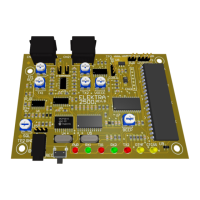ELEKTRA 2500 HAMTRONIX
7
REPEATER AUDIO FIDELITY
The fidelity of the retransmission audio not only depends on the audio circuits of the controller, but where you get it from and
where you send it to.
De-emphasis and Pre-emphasis
Before an FM transmitter transmits the audio on the air, the audio coming from the microphone must pass through a pre-emphasis
circuit. This circuit boosts the audio at 6dB per octave. Pre-emphasis is needed in FM to maintain a good signal to noise ratio. At
the receiver side, a de-emphasis circuit takes the unnatural sounding pre emphasized audio and turns it back into its original
response. Pre emphasized audio is available directly from the audio demodulation (discriminator) circuitry.
How to get the best audio quality
As the input audio comes from the discriminator, it is the audio transmitted by the initial user with pre-emphasis. The controller
adds courtesy beeps, identification and other signaling to this audio and directs it to its output. This output must be connected
directly to the transmitter's modulator (after the pre-emphasis circuit), avoiding any additional treatment to the audio. When a
user receives this audio at the destination, a de-emphasis circuit turns it back into its original audio.
How to get these signals on the transceivers
Many current radios now provide discriminator output (flat audio / disc / det) and modulator input (TX 1200/9600 / flat audio) on
interface connectors for packet radio operation. Commercial radios also often have these signals on service / accessories
connectors, such as Motorola and Vertex. Radios without these facilities have these signals internally. To obtain these internal
signals, a certain technical knowledge is required. If you don't know how to do it, ask a technician for help.
Deemphasize selection on the controller
If your repeater transmitter does not have modulator input available in a packet radio or accessory connector and you don´t know
the point internally, install the jumper J1 for deemphasize the incoming audio to use the MIC input of your transmitter.
There are other variables that can affect the audio. In practice, after making the connections, test the retransmission with and
without the de-emphasis jumper and leave it in the position where the audio fidelity is best for your ears.
CONTROLL COMMANDS
CONTROLLING YOUR REPEATER OVER THE AIR
With exception of the squelch and audio levels, all functions are controlled over the air with your radio DTMF keypad.
COMMAND SINTAXES
Commands are as following: SSSSFF0#
Where SSSS is a 4-digit password (default = 1234), FF is a 2-digit function, O is a 1-digit option and # a enter.
See the command to change the sound of courtesy tone:
1234066#
Your controller will answer valid commands with two high frequency confirmation beeps (function 08 must be
enabled). If the entered command is invalid, a long, low frequency tone will be heard. The command must be entered
completely in one transmission. If you release PTT switch before you complete a command, the entered numbers
will be discarded.
You can enter more than one command without having to release PTT between them. # acts like a command
separator. If entering a command and you made a mistake, just press * to clear the entered string and start over.
To get a correct decoding of DTMF tones, the signal must be free of noises or jamming. If the repeater is busy, wait
until it becomes free prior to sending commands.
Note 1: DTMF commands with incorrect password will not generate an error message. They will just be discarded.
Note 2: DTMF commands with intervals between digits exceeding 2s will be discarded.
Note 3: Some commands don’t require an option or may require extra procedures. These exceptions will be
explained in detail at function description next.
Note 4: Default password is 1234. After getting acquainted with the controller commands, change this password.

